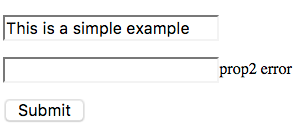Fragment
Fragment
Purpose
Fragment is a ZK component which developers can combine native HTML elements with ZK data binding syntax to make the static page to be dynamic.
Example
<zk>
<fragment viewModel="@id('vm') @init('org.zkoss.fragment.demo.VM2')" validationMessages="@id('vmsgs')"
form="@id('fx') @load(vm) @save(vm, before='submit') @validator(vm.formValidator)"
prop1="@bind(fx.prop1)" prop1err="@bind(vmsgs['fkey1'])"
prop2="@bind(fx.prop2)" prop2err="@bind(vmsgs['fkey2'])"><![CDATA[
<p><input type="text" value="@bind(prop1)"/><span textContent="@load(prop1err)"/></p>
<p><input type="text" value="@bind(prop2)"/><span textContent="@load(prop2err)"/></p>
<button onclick="@command('submit')">Submit</button>
]]></fragment>
</zk>
Data Binding
With Fragment Component, you can bind the properties of ViewModel. For instance, you can use ZK MVVM data binding to access the ViewModel indirectly on the native HTML elements.
These are the supported annotations for now:
- @save
syntax: @save([EL-expression])
- @load
syntax: @load([EL-expression])
- @bind
syntax: @bind([EL-expression])
- @command
syntax: @command([EL-expression], [arbitraryKey]=[EL-expression])
- @global-command
syntax: @global-command([EL-expression], [arbitraryKey]=[EL-expression])
This component also provides a virtual textContent attribute for HTML elements to insert data into the tag.
<zk>
<fragment viewModel="@id('vm') @init('org.zkoss.zktest.test2.F85_ZK_3681_Command_VM')"
status="@bind(vm.status)"><![CDATA[
<div>
<input type="checkbox" onchange="@command('onCheck', checked=event.checked)" />
Check this checkbox: <span textContent="@load(status)"/>
</div>
<div>
<button onclick="@global-command('callGlobal', text='Hello', num=1)">Call global (1)</button>
<button onclick="@global-command('callGlobal', text='World', num=2)">Call global (2)</button>
</div>
]]></fragment>
</zk>
Shadow Elements
In this example, we use if and forEach tags together for condition and collection rendering.
<zk>
<fragment viewModel="@id('vm') @init('org.zkoss.zktest.test2.F85_ZK_3681_Shadow_VM')"
issues="@bind(vm.issues)"><![CDATA[
<section>
<h1>My Issue List</h1>
<ul>
<forEach items="@load(issues)">
<!-- There's a pre-defined variable "each" for convenience. -->
<li>
<!-- @bind(each) is wrong because each is just a temp variable in loops. -->
<input type="checkbox" checked="@load(each.isDone)" />
<if test="@load(each.isDone)">
<strike>[<span textContent="@load(each.id)"/>]
<span textContent="@load(each.description)"/></strike>
</if>
<!-- No else for now. -->
<if test="@load(!each.isDone)">
[<span textContent="@load(each.id)"/>]
<span textContent="@load(each.description)"/>
</if>
</li>
</forEach>
</ul>
<section>
]]></fragment>
</zk>
- For further details, please refer to Shadow components directly.
Data Validation
Server-side Property/Form Validation
To ensure data is correct and useful, we can leverage ZK's validators.
<zk>
<fragment viewModel="@id('vm') @init('org.zkoss.fragment.demo.VM1')" validationMessages="@id('vmsgs')"
prop1="@bind(vm.prop1) @validator(vm.validator1)"
prop1err="@bind(vmsgs['prop1'])"><![CDATA[
<input type="text" value="@bind(prop1)"/>
<span textContent="@load(prop1err)"/>
]]></fragment>
</zk>
You can get the invalid message by assigning a self-defined key as an alias. In order to access invalidate messages by HTML elements, simply bind the messages onto Fragment properties.
Here we can use form-binding and form validators to validate all the fields.
<zk>
<fragment viewModel="@id('vm') @init('foo.BarVM')" validationMessages="@id('vmsgs')"
form="@id('fx') @load(vm.currentUser) @save(vm.currentUser, before='submit') @validator('formBeanValidator', prefix='p_')"
name="@bind(fx.name)" nameerror="@bind(vmsgs['p_name'])"><![CDATA[
<input type="text" value="@bind(name)"/><span textContent="@load(nameerror)"/>
<button onclick="@command('submit')">Submit</button>
]]></fragment>
</zk>
Client-side Property Validation
This component also provides a new @jsvalidator running at client side, accepting custom JavaScript functions for validation. The benefit is that there is no need to send requests to the server for each validation. However, since the validation logic will be exposed at client side, some simple check, such as empty checking or range checking, is recommended. The usage is like @validator but it is effective only on applying to HTML elements.
@jsvalidator
syntax: @jsvalidator(validation_function_name)
The following is the definition of custom JavaScript function.
ValidationFunction(val, vmsgs) * val: The user input data. * vmsgs: The validation message holder object. You can add a invalidate message by adding a new property. If you want to clear the specific message, assign an empty string to the property. * Returns: Boolean. True if the data is valid.
You can use an implicit object (vmsgs) to get the client-side invalid messages. The @jsvalidator has its own validation message holder not shared with server-side.
<zk>
<fragment viewModel="@id('vm') @init('foo.BarVM')" someprop="@bind(vm.prop1)"><![CDATA[
<input type="text" value="@bind(someprop) @jsvalidator('validateExample')"/>
<span textContent="@load(vmsgs['foo'])"/>
<script type="text/javascript">
function validateExample(val, vmsgs) {
var isValid = someValidationProcess(val);
vmsgs['foo'] = isValid ? '' : 'Invalid value';
return isValid;
}
</script>
]]></fragment>
</zk>
The Differences Between @validator and @jsvalidator
| Catalogue | @validator | @jsvalidator |
|---|---|---|
| Validate at | Server side | Client side |
| ZK form validation | Supported | Not supported |
| Validation message holder | Initialized in validationMessages | An implicit vmsgs object |
@validatorrelies on the server, while@jsvalidatorrelies on the browser.@jsvalidatordoes not support form validation.- The validation message holders are not the same.
For security concerns, we recommend you to use server-side @validator in most cases and choose client-side @jsvalidator if the validation needs an instant feedback such as password strength, number range, and so on.
Event Handling
The command of ViewModel can be invoked by attaching DOM events with @command or @global-command on HTML elements. Once the DOM event is triggered (i.g. clicked or changed), the command of ViewModel will be executed and receive the corresponding event object.
You can get more details from the event object such as mouse cursor position, pressed keys, entered text, and selected text.
| ZK Event object | DOM event |
|---|---|
| MouseEvent | onclick |
| oncontextmenu | |
| ondblclick | |
| onmousedown | |
| onmouseenter | |
| onmouseleave | |
| onmouseover | |
| onmouseout | |
| onmouseup | |
| ondrag | |
| KeyEvent | onkeydown |
| onkeypress | |
| onkeyup | |
| InputEvent | onchange |
| oninput | |
| CheckEvent | onchange (checkbox) |
| oninput (checkbox) | |
| SelectionEvent | onselect |
| DropEvent | ondrop |
| Event | onblur |
| onfocus | |
| onfocusin | |
| onfocusout |
- For further details about how to retrieve the event object, please refer to Retrieve Event Object directly.
Properties
- content: specify the content of this component.
- src: specify the URI of an external content file. The file encoding is assumed to be UTF-8.
- recoverId: specify the recover ID.
Supported Events
| Event: Event
Represents an event sent back to the server caused by an offline recovery. |
Supported Children
None
Use Cases
| Version | Description | Example Location |
|---|---|---|
| 8.5+ | Data binding, Shadow elements | Client Binding with ZK MVVM for your eyes only |
| 8.5+ | Data validation, Event handling |
Version History
| Version | Date | Content |
|---|---|---|
| 8.5 | 2017/09/21 | Add the new Fragment component |
